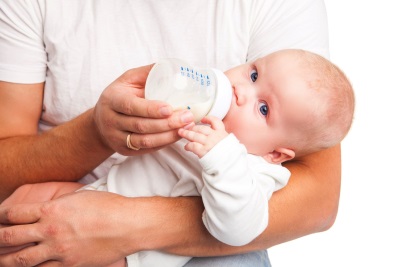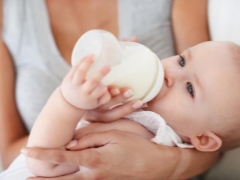Lactose free formulas for children - list and analysis of composition
Lactose-free mixtures are produced by almost every major baby food manufacturer. If the product is lactose-free, then the content of milk sugar in it is nearing zero. Why are they needed and what are they?
In what cases are used
Mixes without lactose or with a low content of milk sugar are prescribed for bottle-fed children who have developed symptoms of lactase deficiency. Since the enzyme activity is often only partially reduced, it is not necessary to completely switch to them. You can mix for one portion of the adapted mixture and lactose-free, the amount of which is selected individually.
Indication for use is and secondary form of lactose intolerance caused by intestinal diseases. For example, when a child has an intestinal infection, after a pediatrician is prescribed, the child can be completely transferred to a lactose-free mixture. As soon as the crumb recovers, you should gradually return to its diet the usual milk mixture.
Premature babies, who often detect transient lactase deficiency, They are fed with food intended specifically for premature babies. It contains less lactose than normal.
Mixes without lactose are also used as a basis for the preparation of cereals and mashed potatoes during the introduction of complementary foods to children with lactase deficiency.
Note that stop breastfeeding with lactase deficiency not necessary.
Fully exclude lactose is only necessary in the congenital form of the disease, which is extremely rare. In most children, lactase deficiency is represented by a transient form, in which the enzyme activity is reduced only temporarily.
Lactose It is very important for the development of intestinal microflora, and for the baby’s nervous system. In addition, in breast milk there are many other components that are very valuable for crumbs.
The best way for breastfed babies is to use lactase drugs.
Dr. Komarovsky in one of his answers on the topic of lactase deficiency expressed the opinion that this diagnosis is often exaggerated in order to increase sales of low-lactose mixtures. The recommendations of doctors to young mommies to stop breastfeeding and giving them to the baby have become too frequent. As soon as the mother complains that the baby has a foamy greenish stool, the pediatrician immediately begins to suspect lactose intolerance and prescribe the mixture without this carbohydrate. In fact, they are often faced with a functional form of failure.
Special features
Lactose-free mixtures are therapeutic baby food, so they must be prescribed by a doctor. Independently decide whether to feed them a crumb, it is not necessary. Lactose is extremely important for the infant's body and unreasonable feeding of the crumbs with a lactose-free product can cause harm to the baby’s health.

Features:
- Most often, they are prescribed only for a while, and after each course of feeding the child with a lactose-free product, it is necessary to check whether the lactose uptake of the baby has improved.
- They can be made from milk or soy protein. And if there are no lactose in soybean mixtures at all, then traces of this disaccharide can be detected in milk products.
- Many pediatricians recommend soybean mixtures as a lactose-free diet, but babies may develop an allergy to this type of diet.
- Tastes are quite low, so many children refuse them.
- With long-term feeding may develop problems with digestion - discoloration of feces, diarrhea, bloating, colic, a violation of the microflora.
- With a sharp introduction, the child may begin constipation.
The transfer of the baby to a lactose free mixture should be gradual. On the first day, add 30 ml of the new product to the usual mixture in one feeding. On the second day, the lactose-free mixture is added to two feeds of 60 ml each. The next day, two feedings are replaced with a lactose free product. Then the child can be fed only to her.
Difference from adapted
The adapted mixture is created in such a way as to maximally remind female milk with its composition. For her, cow or goat's milk is used as the main ingredient. Unlike such an adapted mixture, there is very little or no milk in a low- or lactose-free diet. Most often, the milk in such mixtures is replaced by soy.
The main difference is the absence of a carbohydrate called lactose. This carbohydrate is in human milk and is necessarily present in the adapted mixtures. If you look at the microelement and vitamin composition, it is noticeable that they are not inferior to milk mixtures.

List
The following manufacturers have lactose-free milk formula:
- Nan;
- Mamex;
- Celia lactofry;
- Nutrilon;
- Enfamil lactofry;
- Nutrilak;
- Bellakt;
- Grandmother's basket.
Carbohydrates in lactose-free mixtures are usually represented. maltodextrin. The fat component is represented by a mix of vegetable oils, including palm oil.
Review and analysis of the composition
In the majority of lactose-free milk-based mixtures, the proportion of whey proteins to casein is 60: 40. Only in the Enfamil mixture, this ratio is 20: 80, and Nutrilon is represented entirely by casein. In Nan and Celia there are probiotics (bifidobacteria). Prebiotics are not added to this diet. In all mixtures, with the exception of Enfamil, there are nucleotides. The highest osmolality is determined by the Celia mixture.
For mixtures that do not include lactose, soy-based products are also included.
Also, lactose is not in such hypoallergenic mixtures, such as:
- Alphare;
- Nutrilon Amino Acids;
- Nutrilak peptide STTC.
Among soy baby food with lactase deficiency, Nutrilon soy is often prescribed. Its basis is soy isolate, so there is no animal protein in it at all, which makes it also an excellent product for allergies (especially if an allergic bowel disease led to secondary lactose intolerance).
There is no glucose in the lactose-free Nane, therefore it is recommended for newborns with intolerance to regular sugar. Carbohydrates in this product are represented by corn syrup. Also in this mixture are added substances that stimulate the restoration of the intestinal mucosa.
It is impossible to say that some lactose-free mixtures are better than others. Each of them has its own advantages and special characteristics due to which nutrition can be chosen individually, taking into account the state of health of the infant.
When to expect stool normalization?
With the introduction of lactose-free mixtures into the baby’s diet, stopping the stool normalization is expected on the third to fifth day. Usually, the stool is completely normalized to 5-7 days from the start of feeding on lactose-free diet. The baby's condition improves, and he begins to gain weight.
On the treatment of lactose deficiency in infants, see the transfer of Dr. Komarovsky.











